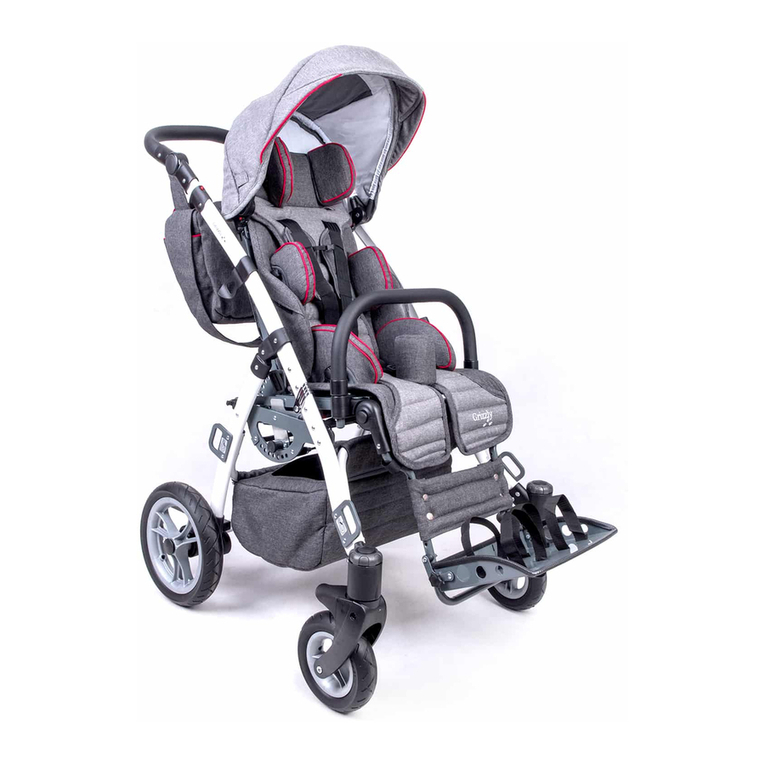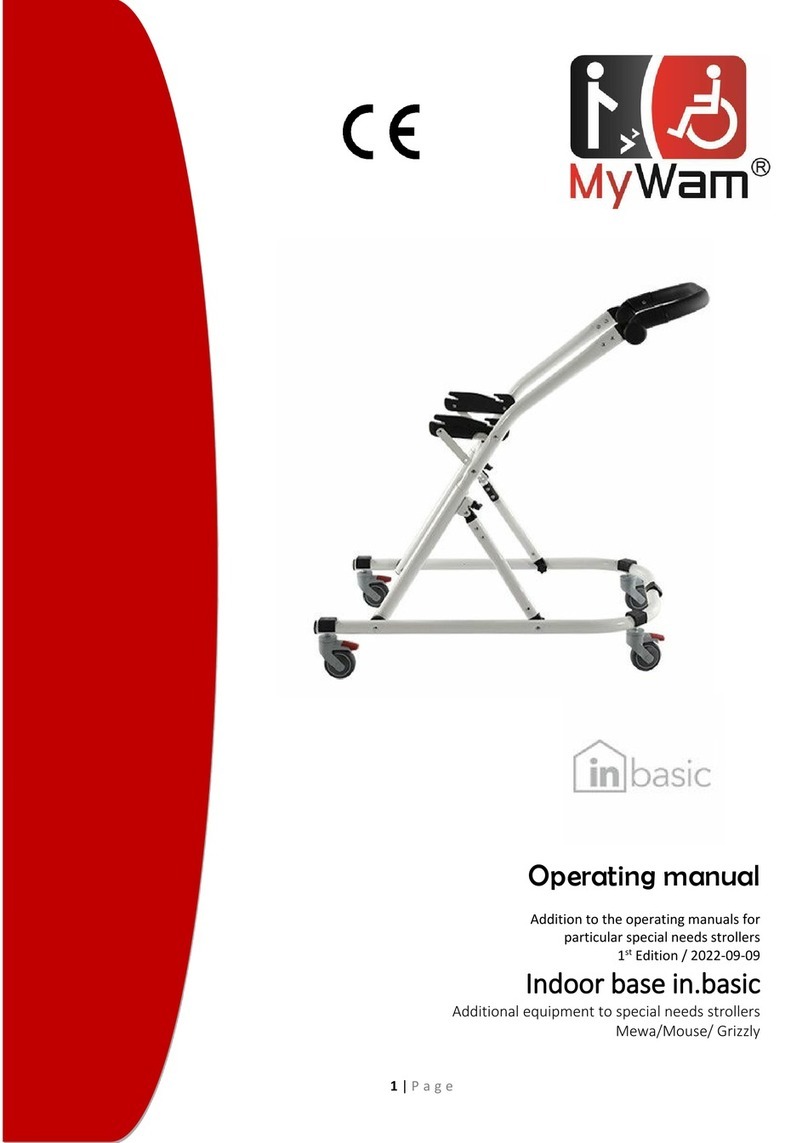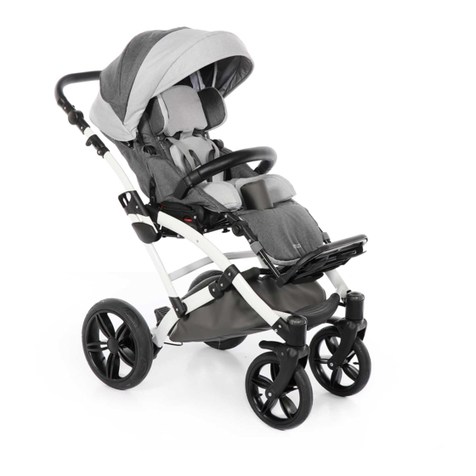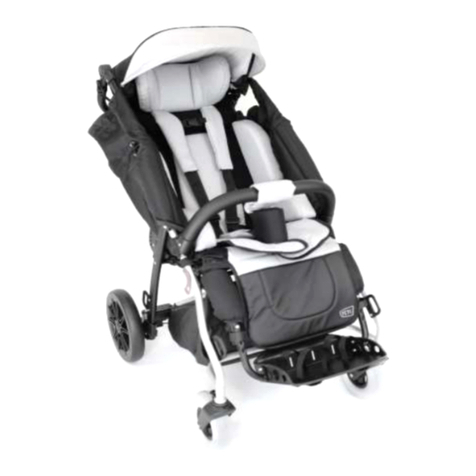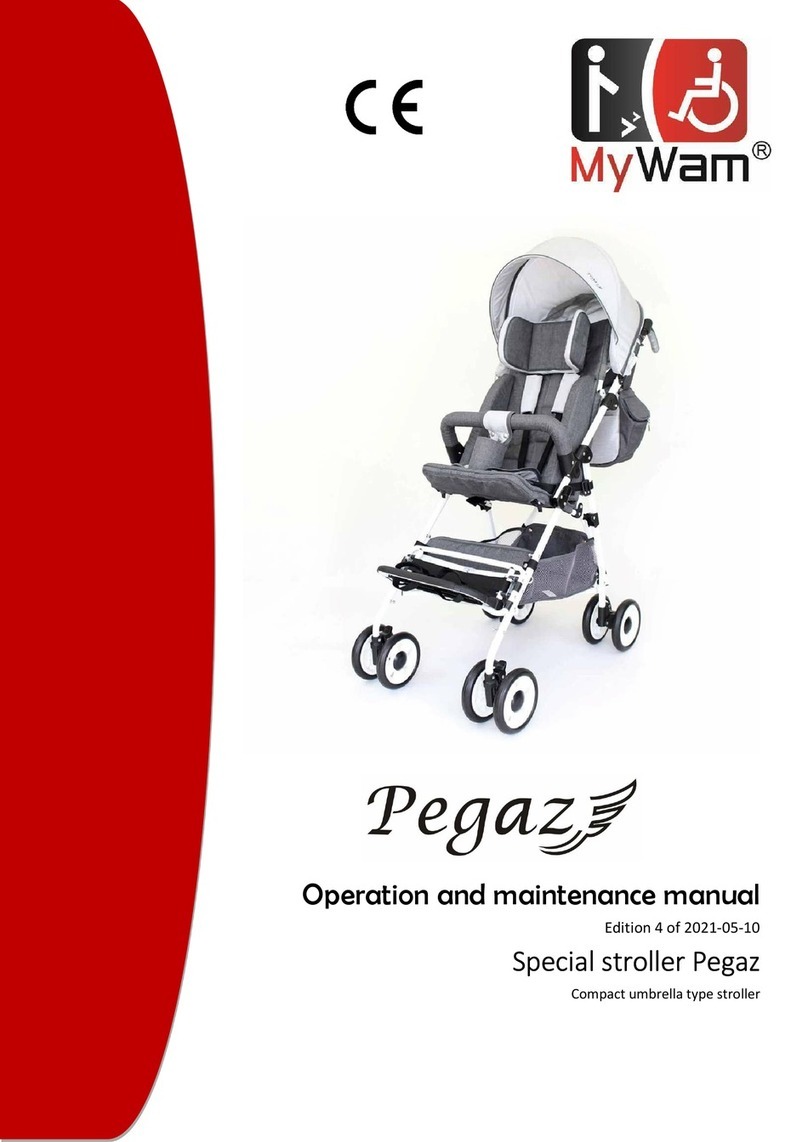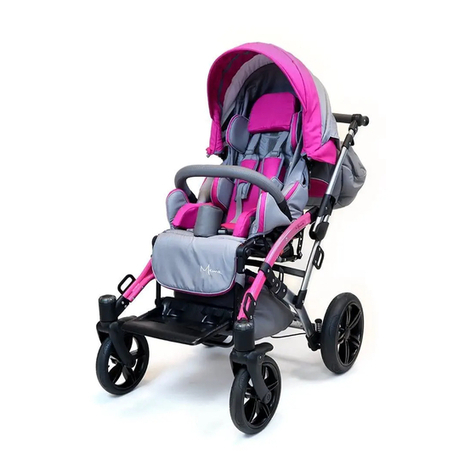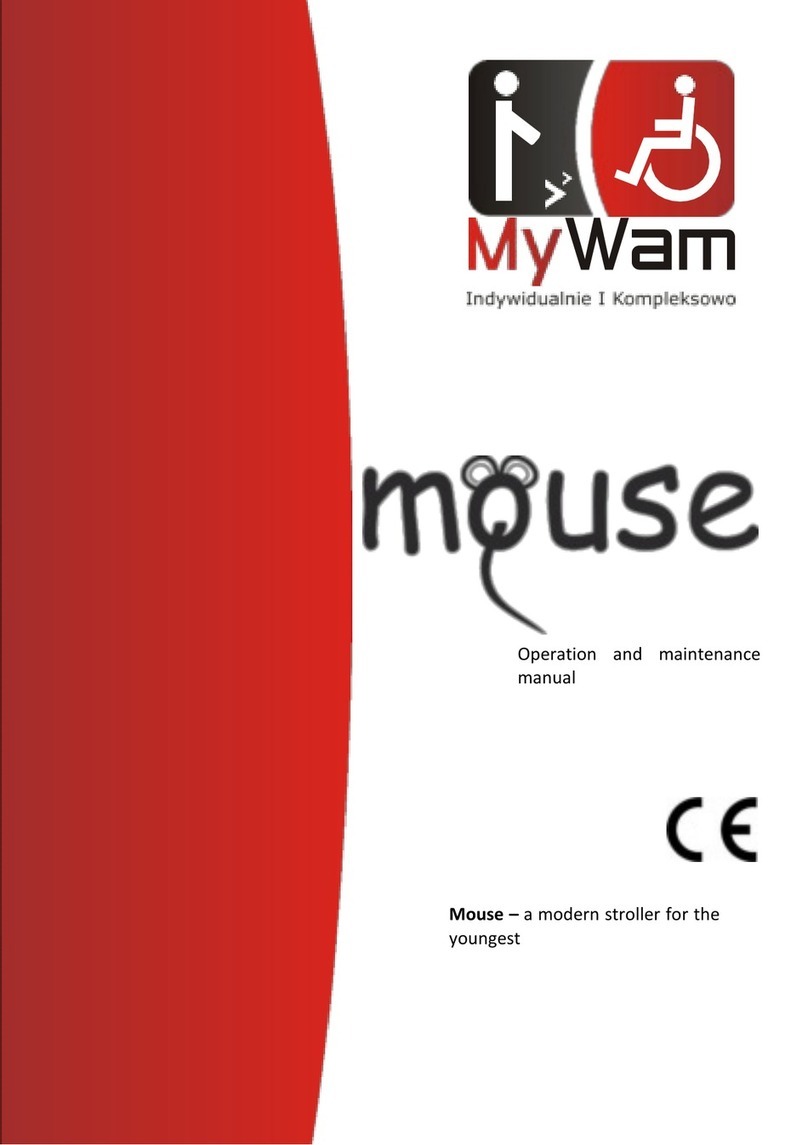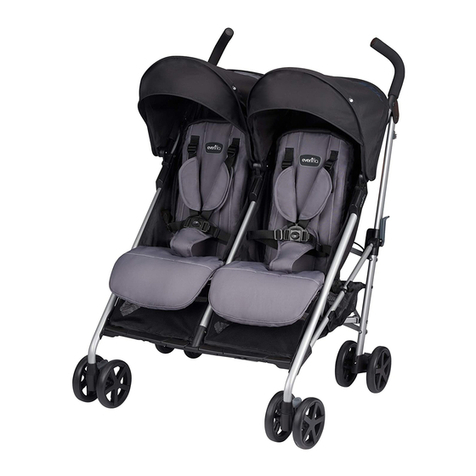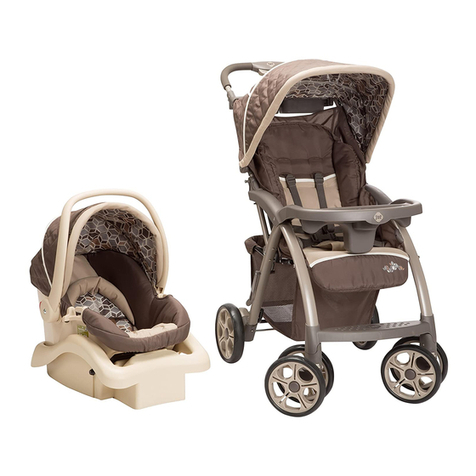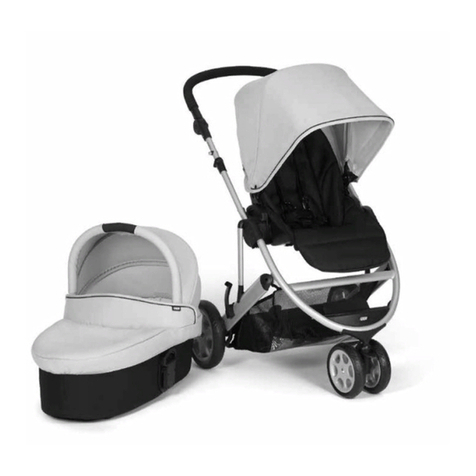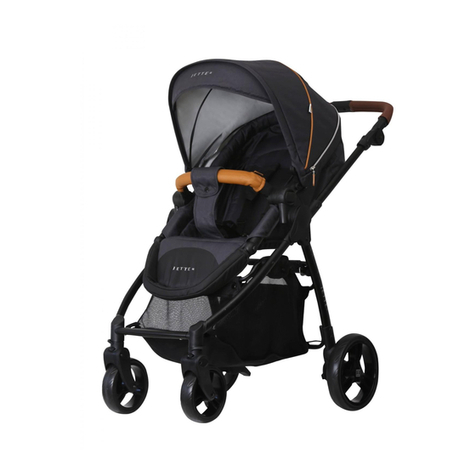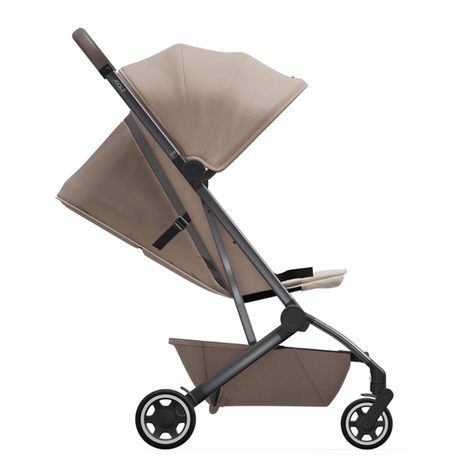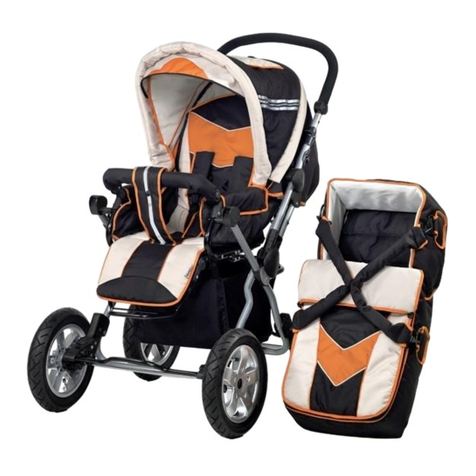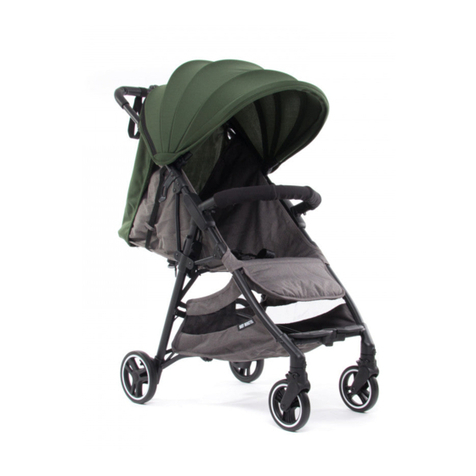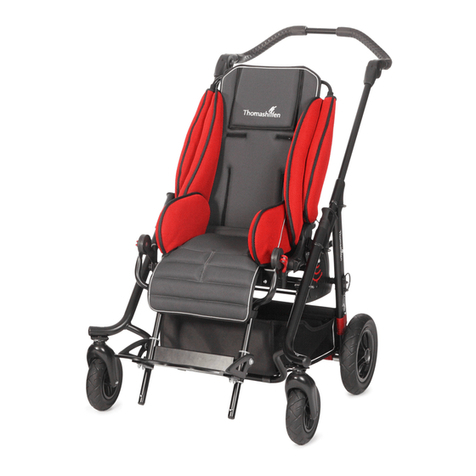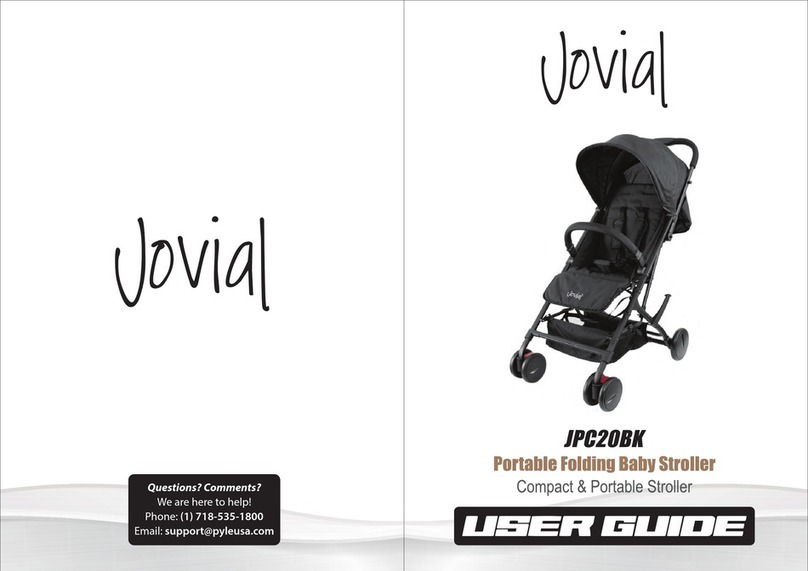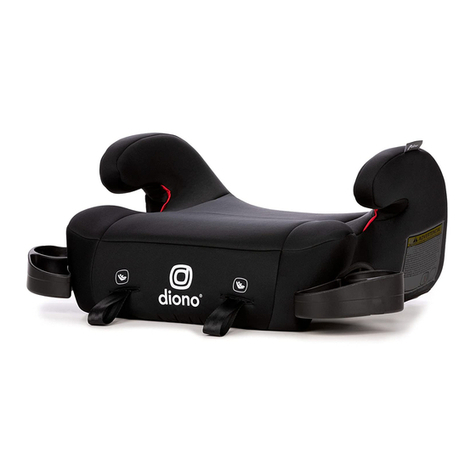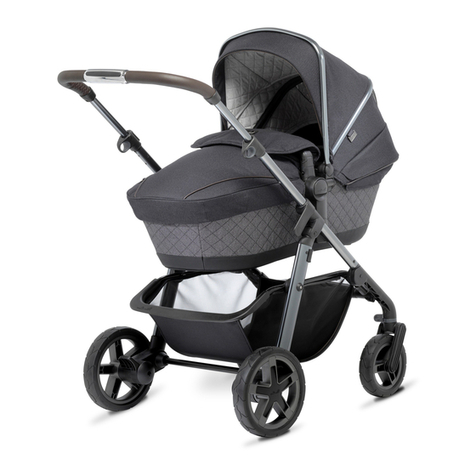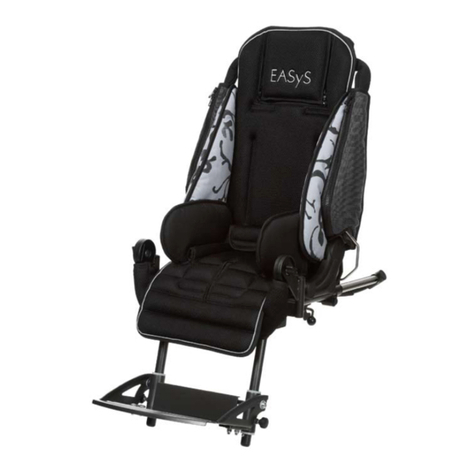MyWam Yeti User manual

Operation and maintenance manual
Edition 7 / 2022-10-25
The special stroller YETI
The special pediatric stroller YETI Young

YETI Edition 7 / 2022-10-25
2 | P a g e
ATTENTION! Users with sight, reading or cognitive
impairment are requested to report to the Manufacturer in
order to obtain information in the appropriate format.
Purpose of the Manual
The operation and maintenance manual contains basic information necessary for the correct use of the
Yeti and Yeti Young strollers, including the principles of safe use, description of its construction, operation
and adjustment, preparation of the stroller for operation, how to maintain and clean the stroller, and
warranty conditions.
It is designed for persons who directly care of children with disabilities (childcare assistans, parents,
guardians), which will be transported in a stroller. It is also intended for doctors and physiotherapists
operating the stroller.
ATTENTION! Before using the stroller, each User is obliged to read the manual and act in accordance with
its guidelines.
This manual is an integral part of the product and must always be attached to the product wherever being
sold. Keep this manual for future reference! Keep the manual in an easily accessible place. The manual in
the electronic version is available on the website www.mywam.eu
ATTENTION! In the event of any medical incidents related to the presence of the Yeti and Yeti Young
strollers, the Manufacturer must be immediately notified in writing by contacting it via registered letter
or e-mail with acknowledgment of receipt.
Manufacturer's contact details:
● Postal address: MyWam sp.j., ul. Szczecińska 10, 41-516 Chorzów, Poland
● contact phone number: +48 32 733 11 31
● e-mail address: mywam@mywam.pl
User and maintenance manual version: EN Edition 7 / 2022-10-25
MyWamKupiec, Bartold, Angres sp.j. reserves the right to make technical and commercial changes to the
content of the Operation and Maintenance Manual without prior notice. Each change will be determined
by the date the instructions were last updated .

YETI Edition 7 / 2022-10-25
3 | P a g e
Table of Contents
Introduction ........................................................................................................................................................................... 5
1. Intended use of the Yeti/Yeti Young stroller .................................................................................................................... 5
2. Basic information about the Yeti stroller.......................................................................................................................... 5
3. Quick start ........................................................................................................................................................................ 6
Safety ..................................................................................................................................................................................... 7
4. Important instructions and safety rules .......................................................................................................................... 7
5. Identification plate ........................................................................................................................................................... 8
6. Warning labels .................................................................................................................................................................. 8
7. Marking of symbols .......................................................................................................................................................... 8
Product .................................................................................................................................................................................. 9
8. General construction of the stroller ................................................................................................................................. 9
9. Configuration and use –stroller frame.......................................................................................................................... 11
Frame folding mechanism...................................................................................................................................... 11
Unfolding the stroller frame .................................................................................................................................. 11
Folding the stroller frame ...................................................................................................................................... 12
Transport lock. Installing and removing the transport lock ................................................................................... 12
Swivel front wheels. Locking the direction of travel of the front wheels .............................................................. 12
Rear wheels. Installation and removal of rear wheels on the axle ....................................................................... 13
Rear wheel amortization system ........................................................................................................................... 13
Ergonomic handle for pushing the stroller. Mechanism and angle adjustment of the handle. ............................ 13
Central brake. Applying and deactivating the brake............................................................................................. 14
Tilting foot............................................................................................................................................................. 14
Frame adjustment in terms of seat depth ............................................................................................................. 14
Adjusting the frame in terms of changing the seat angle. .................................................................................... 15
Frame adjustment in terms of backrest height..................................................................................................... 15
Adjusting the frame within the angle of the backrest ........................................................................................... 15
Footrest. Regulation and use. ................................................................................................................................ 16
10. Configuration and use - therapeutic seat with backrest ............................................................................................ 17
Stroller upholstery. Installation of upholstery on the stroller frame. Disassembly............................................... 17
Adjustable tension system ..................................................................................................................................... 18
Seat and backrest upholstery adjustment ............................................................................................................. 18
Five-point belts ...................................................................................................................................................... 19
11. Additional equipment ................................................................................................................................................ 20
Safety barrier ......................................................................................................................................................... 20
Therapeutic table .................................................................................................................................................. 20
Abduction and stabilizing belts ............................................................................................................................. 20
Seat minimizing kit................................................................................................................................................. 21
The head restraint.................................................................................................................................................. 21
Adjustable canopy with window ........................................................................................................................... 22
Travel bag.............................................................................................................................................................. 22
Shopping basket..................................................................................................................................................... 22

YETI Edition 7 / 2022-10-25
4 | P a g e
Wedge.................................................................................................................................................................... 23
Raincover........................................................................................................................................................... 23
Winter gloves..................................................................................................................................................... 23
Winter sleeping bag........................................................................................................................................... 24
Mosquito net ..................................................................................................................................................... 24
Sun umbrella..................................................................................................................................................... 24
12. Technical specification of the Yeti stroller ................................................................................................................. 25
Material composition of the stroller...................................................................................................................... 25
13. Delivery and tools....................................................................................................................................................... 25
14. Assembly and disassembly of the stroller .................................................................................................................. 26
15. Preparation for use .................................................................................................................................................... 27
16. Using the stroller ........................................................................................................................................................ 27
Carrying the stroller ............................................................................................................................................... 27
Getting on and off the stroller ............................................................................................................................... 28
Correct position in a stroller .................................................................................................................................. 28
Riding in a stroller .................................................................................................................................................. 28
Moving on slopes ................................................................................................................................................... 28
Overcoming thresholds or curbs............................................................................................................................ 29
Transport in a car and other vehicles .................................................................................................................... 29
Cleaning and care................................................................................................................................................... 29
17. Storage of the stroller ................................................................................................................................................ 30
Preparation of the stroller for long-term storage.................................................................................................. 30
Corrosion protection.............................................................................................................................................. 30
18. Re-use......................................................................................................................................................................... 30
19. Service and periodic inspections................................................................................................................................ 31
20. Disposal ...................................................................................................................................................................... 31
21. Compliance with requirements for medical devices .................................................................................................. 32
22. Notes .......................................................................................................................................................................... 33
23. List of authorized service points ................................................................................................................................ 34
24. Warranty Card............................................................................................................................................................ 35
25. Warranty conditions................................................................................................................................................... 35

YETI Edition 7 / 2022-10-25
5 | P a g e
Introduction
Thank you for purchasing special stroller Yeti/Yeti Young for young people and adults. We hope that
it will be the cause of many wonderful moments with your child and will be helpful every day. We make
every effort to ensure that our products meet your expectations and the highest standards. We encourage
you to contact our employees and follow us on our website www.mywam.eu and on social media. There
you can find out many interesting things about our products.
1. Intended use of the Yeti/Yeti Young stroller
Yeti/ Yeti Young stroller is a multi-functional stroller for disabled users. The stroller is based on a frame made of aluminum and
steel elements. Enables quick removal of the rear wheels. "Yeti" is a complete therapeutic system that allows you to adjust the
angle of the backrest and footrest, the length of the footrest, the position of the headrest, etc. The product is equipped with a
number of accessories improving the functionality and comfort of use, such as: narrowing inserts, table, safety belts, wedge,
booth, mosquito net, sleeping bag shopping bag etc.
The special stroller "Yeti" and the special pediatric stroller YETI Young is a medical device class I indicated for use by disabled
people who, due to their condition, cannot walk and / or sit down on their own. The product is intended for the transport and
movement of the above mentioned people in a sitting or lying position and for posture correction and this is its intended use.
Clinical indications include cerebral palsy, meningeal hernia, dystrophies, paresis, etc.
The product is intended for users from 130-175 cm. Users cannot drive the stroller alone, but only with the help of a guardian.
The stroller can be used indoors and outdoors, on various surfaces (asphalt, concrete, stone, gravel) and in various weather
conditions. Any other use of the product than described is forbidden. The product should be used in accordance with the
recommendations of the attending physician or physiotherapist. The stroller must be used in the instructions for use only by
adults caring for the user. Young people and children as well as any other persons without proper training should not use the
product.
Contraindications:
In case of contraindication to the sitting position and/or passive upright positioning, the adjustment of the stroller should be
consulted with a physiotherapist or attending physician.
2. Basic information about the Yeti stroller
The Yeti/ Yeti Young stroller has many options, e.g.:
changing the angle of inclination of the backrest (see point 9.14)
backrest height adjustment (see point 9.13)
seat angle adjustment (see point 9.12)
seat depth adjustment (see point 9.11 and 11.13)
footrest adjustment (see point 9.15)
head stabilization (see point 11.5)
torso stabilization (see point 10.4, 11.3, 11.4, 11.9)
optional equipment (see point 11)

YETI Edition 7 / 2022-10-25
6 | P a g e
3. Quick start
To quickly use the stroller it must be unpacked and prepared for use according to item 14 Assembly and disassembly of the
stroller and item 15 Preparation for use. The following is a pictorial diagram, but it will not replace careful reading of the
complete manual.

YETI Edition 7 / 2022-10-25
7 | P a g e
Safety
4. Important instructions and safety rules
General tips:
•It is forbidden to use the stroller in a way for which the stroller is not dedicated.
•The product contains small parts that can be dangerous if swallowed by a child!
•Due to the large adjustment possibilities of the stroller, during the angular adjustment of the seat and angular adjustment
of the backrest, it is possible to set the position in which the child's head is below the pelvic line. It is forbidden to use this
position as it could lead to the risk of the child choking.
•It is forbidden to put additional weight on the stroller, especially when it comes to placing an additional weight on the
back of the backrest, e.g. a backpack or a bag. This may cause the Yeti stroller to tip over and injure the user! It does not apply
to original additional accessories dedicated to the Yeti stroller that do not exceed the permissible load. All additional elements
attached to the stroller affect its stability.
•ATTENTION! Depending on the adjustments made for the Yeti stroller - it concerns the setting of the stroller's push handle,
backrest height adjustment, backrest angular adjustment, seat depth adjustment, seat angle adjustment, footrest angle
adjustment and footrest adjustment - this stroller may exceed the maximum dimensions.
•ATTENTION! Each time the stroller is used, the steps listed below must be performed and the stroller must not be used in
the event of any irregularities. In such a situation, it is recommended to urgently contact the Seller and/or the Manufacturer for
advice.
•ATTENTION! When driving through doors or similar restrictions restricting the direction of travel of the stroller, make sure
that there is adequate space on both sides of the stroller to prevent pinching of hands or other body parts and to prevent
damage to the stroller.
ATTENTION!
•Never leave your child unattended in a stroller, as there is a risk of injury and there is a risk of accident!
•This product is not suitable for running, skating or roller-skating
•This stroller is not intended as a seat in a motor vehicle
•Beware of gaps and moving parts –risk of jamming
•Do not carry the stroller with the child inside it
The stroller is packed in a plastic bag. The plastic bag is not a toy and should be kept away from infants and young children as
it may cause suffocation when put on a head
•ATTENTION! It is forbidden to use the stroller if the technical condition of the stroller or a single element of the stroller is
bad or the user has any doubts about it, the stroller is damaged or there is a suspicion that damage has occurred or if the
operation of the stroller is not correct. In such a situation, it is recommended to urgently contact the Seller and/or the
Manufacturer for advice.

YETI Edition 7 / 2022-10-25
8 | P a g e
5. Identification plate
The nameplate contains basic information about the product: name,
model, serial number (ID no.), maximum load, manufacture date, CE
mark, medical device mark, and also certain warning in accordance with
the Operation and Maintenance Manual and manufacturer's data (see
Fig. 5.1).
The nameplate is located on the crossbeam at the rear of the stroller
frame, on its left side, glued from above.
Plate with UDI code
Plate with UDI code includes the following information: name, model,
UDI code, details of manufacturer (see Fig. 5.2)
6. Warning labels
The warning label contains important warnings for the user (see Fig.
6.1).
The warning label is located on the rear/side part of the frame on both
sides.
7. Marking of symbols
Product serial number
The manufacturer's name
Permitted total user weight
The product is a medical device
Date of manufacture
DESCRIPTION "WARNING!" and the symbol in this
manual are used to enhance the reader's
attention to the content marked with this sign.
Non-compliance with content marked with this
description may endanger the health and safety
of the user and accompanying persons, and may
also damage the product.
Conformity assessment mark
according to applicable European
regulations and directives
Warning about proceeding in
accordance with the product
Operation and Maintenance
Manual
Fig. 5.1
Fig. 5.2
Fig. 6.1

YETI Edition 7 / 2022-10-25
9 | P a g e
Product
8. General construction of the stroller
The Special Stroller Yeti and the special pediatric stroller YETI Young for children consist of two main parts:
the frame of the stroller with seat and backrest. Yeti/ Yeti Young offers a wide range of accessories that
help to meet individual needs of the users.
Steel stroller frame with seat and backrest
The basic elements of the stroller frame include:
1-
Ergonomic handle for pushing the stroller -
see point 9.8
2-
String adjustment of excess upholstery - see point 10.3
3-
Five-point belts - see point 10.4
4-
Removable backrest and seat upholstery - see point 10.1
5-
Slit for storing excess upholstery - see point 10.1
6-
Frame wrapper - see point 10.1
7-
Adjustable footrest with straps - see point 9.15
8-
Tilt foot - see point 9.10
9-
Central brake - see point 9.9
10-
Rear wheel shock absorption system - see point 9.7
11-
Rear wheels, solid - see point 9.6
12-
Angle adjustment mechanism of the push handle
- see point 9.8
13-
Frame folding mechanism - see point 9.1
14-
Backrest angle adjustment - see point 9.14
15-
Seat depth adjustment - see point 9.11
16-
Seat angle adjustment - see point 9.12
17-
Backrest height adjustment - see point 9.13
18-
Frame folding mechanism lock - see point 9.3
19-
Angle adjustment mechanism of the entire footrest
- see point 9.15
20-
Backrest angle adjustment mechanism - see point 9.14
21-
Transport lock - see point 9.4
22-
Footrest length adjustment - see point 9.15
23-
Quick rear wheels assembly mechanism - see point 9.6
24-
Lock of the direction of travel of the front wheels
- see point 9.5
25-
Front swivel wheels - see point 9.5

YETI Edition 7 / 2022-10-25
10 | P a g e
Accessories:
oSafety barrier see point 11.1
oTherapy table see point 11.2
oAbduction and stabilizing belt see point 11.3
oSeat minimizing kit see point 11.4
oHeadrest with adjustment↕see point 11.5
oAdjustable canopy with window see point 11.6
oTravel bag see point 11.7
oShopping basket see point 11.8
oWedge see point 11.9
oRaincover see point 11.10
oWinter gloves point 11.11
oWinter sleeping bag see point 11.12
oMosquito net see point 11.13
oSun umbrella see point 11.14

YETI Edition 7 / 2022-10-25
11 | P a g e
9. Configuration and use –stroller frame
Frame folding mechanism
The frame folding mechanism is located inside the frame and on the
frame in two places in its right part and in three places in its left part.
Describing these places from above, from the side of the handle to
push the stroller, these are:
right and left bend - an element that allows folding the upper
frame to reduce its dimensions
mechanism of folding the frame with a lock
Unfolding the stroller frame
To unfold (open) the stroller frame: lay the stroller frame horizontally
on the ground and pull off the transport lock (Fig. 9.2.1). Then gently pull the backrest to the upright
position (Fig. 9.2.2.).
Fig. 9.2.1 Fig. 9.2.2
To set the stroller, pull the handle carefully by lifting it slightly up while bringing the stroller to the desired
position (Fig. 9.2.3) until the frame folding lock engages (Fig. 9.2.4). The frame of the stroller will not
unfold properly until the frame folding mechanism has been properly closed. This is evidenced by the
clear "click" sound coming from the well-closed mechanism of folding the frame.
Fig. 9.2.3 Fig. 9.2.4
Fig. 9.1

YETI Edition 7 / 2022-10-25
12 | P a g e
Folding the stroller frame
To fold (close) the stroller frame: release the frame folding mechanism lock
by pulling it up and pull both frame folding handles up until the frame is
released. (Fig. 9.3) Then fold the stroller frame folding it forward in the
direction of the front wheels. Make sure that the push handle and footrest
are in a non-colliding position. Then pull the backrest release mechanism. Put
on a transport lock.
Transport lock. Installing and removing the transport lock
The stroller is equipped with a transport lock, which serves to protect the
folded (closed) stroller frame against its automatic opening during transport
and storage.
The transport lock consists of two parts: an eyelet and a pin (male element).
In order to secure the frame against its automatic opening, first fold the
frame, and then put the locking eye on the locking pin so that both of these
elements closely overlap (Fig. 4.4.).
To unlock the transport lock, before unfolding the frame, remove the locking eye from the locking bolt
and only then can the unfolding of the stroller frame be started.
Swivel front wheels. Locking the direction of travel of the front wheels
The used, durable wheels guarantee the highest quality of stroller driving, driving pleasure and elegant
appearance. The tires are tubeless, filled with a special gel that has shock absorbing properties very similar
to those of inflatable wheels. The wheels are factory-fitted to the front wheel forks, which are finished
with top steering axles from above.
Both front wheels can be set for straight-ahead or unlocked for turning, which makes it much easier to
maneuver the stroller. Thanks to the locking of the direction of travel of the front wheels and the
possibility of putting it on or taking off, there is clearly greater comfort for both the child and the assistant
when driving the stroller.
It is recommended to remove the lock and allow the front wheels to turn while driving the stroller on a
completely smooth surface, e.g. in shopping centers, school.
In the event of uneven surfaces, moving on sloping
surfaces, when crossing thresholds or curbs, it is
recommended to install the lock and block the turning
of the front wheels.
To prevent the front wheels from turning, put the lock
knob into the gap - see Fig. 9.5.1. To unblock the
turning of the front wheels, pull back and turn the
locking knob and leave them outside the gap - see Fig.
9.5.2.
Fig. 9.5.1
Fig. 9.3
Fig. 9.4
Fig. 9.5.2

YETI Edition 7 / 2022-10-25
13 | P a g e
Rear wheels. Installation and removal of rear wheels on the axle
The used, durable wheels guarantee the highest quality of stroller driving,
driving pleasure and elegant appearance. The tires are tubeless, filled with
a special gel that has shock absorbing properties very similar to those of
inflatable wheels.
Thanks to the possibility of dismounting both the wheels and their axle, the
stroller is smaller after folding, which facilitates its transport and storage.
The wheel assembly mechanism is mounted inside the rear wheels and
ensures quick assembly and disassembly of the rear wheels. It is started by
pressing the quick assembly clamp (Fig. 9.6.1) towards the center of the
wheel, after which the rear wheel can be mounted on the rear wheel axle or
the rear wheel can be removed from the rear wheel axle.
Wheels mounting on axle
When installing the rear wheel on the rear wheel axle, press the clamp in the
center of the wheel and put the wheel on the beginning of its axle. Then stop
pressing the clamp and continue sliding the wheel onto its axle until it clicks.
The correct wheel placement is demonstrated by the clear "click" sound
coming from the quick axle rear axle mounting mechanism.
Dismantling the wheels from the axle
In order to remove the rear wheel from the rear wheel axle, press the clamp in the middle of the wheel
and slide the wheel out of its axle. - Fig. 9.6.2.
Rear wheel amortization system
The stroller is equipped with spring-loaded cushioning of the frame and rear
wheels, located at the ends of the rear legs of the frame, when in contact
with the crossbeam. Amortization works automatically. The adjustment is
done by activating the up-down lever located from the bottom of the shock
absorber. In order to facilitate the switchover of settings by the lever,
simultaneous pressure on the shock absorber spring is allowed. When the
lever is shifted, the shock absorber spring will be compressed (option for
hard ground) or extended (soft ground).
Ergonomic handle for pushing the stroller. Mechanism and angle adjustment of the handle.
The handle is used to push the stroller, providing a firm grip in various
driving conditions. It has the ability to adjust the height of the handle for
the child's assistant who drives the stroller - Fig. 9.8
Adjustment mechanism.
These are two buttons on the outside of the frame, located on the joints
of the handle to push the stroller.
Angle adjustment of the stroller push handle
To change the angle of the stroller push handle, push both buttons of the
angle adjustment mechanism of the push handle and change its angle.
Fig. 9.7
Fig. 9.6.1
Fig. 9.6.2
Fig. 9.8

YETI Edition 7 / 2022-10-25
14 | P a g e
After setting the handle in the correct position, stop pressing the buttons, which will automatically lock
the push handle in the desired position.
Central brake. Applying and deactivating the brake
The central brake pedal (Fig. 9.9), which when pressed blocks the two rear
wheels of the stroller directly, is located in the middle of the crossbeam, at the
rear of the stroller frame.
Central brake on and off
To apply the central brake, press the brake pedal down towards the ground
until it clicks. The correct activation of the brake is indicated by a clear "click"
sound from the central brake.
To disengage the central brake, pull the brake pedal up.
Tilting foot
The tilting foot (Fig. 9.10) is located on the right side of the crossbeam, at
the rear of the stroller frame. In order to use it, press the tilting foot and at
the same time pull the handle to push the stroller, which in turn will cause
the front of the stroller to rise up together with the front wheels.
Using the tilting foot makes it easier for the stroller to climb onto small steps
or curbs.
Frame adjustment in terms of seat depth
The stroller has the option of adjusting the seat depth. To do
this, activate the central brake so that the stroller is stable
and immobilized, then loosen the screw with an Allen key
from both sides of the frame (locking position) and extend or
slide the seat frame (seat frame) evenly into the desired
position. The correct position must be secured by tightening
the screw on the sides of the frame. The frame can be pulled
out leaving a minimum of 15cm overlaps of steel frame
elements. See Fig. 9.11
The frame adjustment is in the range of 30 to 45 cm. The
adjustment range of seat upholstery is described in point
10.2.
Fig. 9.9
Fig. 9.10
Fig. 9.11

YETI Edition 7 / 2022-10-25
15 | P a g e
Adjusting the frame in terms of changing the seat
angle.
The stroller has the ability to adjust the seat angle in the
range of 10˚ to 30˚ (from level), every 5˚. The seat angle
adjustment mechanism consists of a comb on the right and
left side of the stroller, to which the stroller frame is
attached with a screw.
To set the right seat angle, activate the central brake so
that the stroller is stable and immobilized, then unscrew the
screw on both sides of the comb, set the seat according to
the selected position and tighten the screw in the correct
position. A Phillips screwdriver is required for this
operation. See Fig. 9.12.
The upholstery adjustment range is described in point
10.3
Frame adjustment in terms of backrest height
The stroller has adjustable backrest height. To do this, activate
the central brake so that the stroller is stable and immobilized,
then loosen the screw with the Allen key from the sides of the
frame (locking position) and extend or slide the backrest
(backrest frame) evenly into the desired position. Then secure
the selected position by tightening the screw. The frame can be
pulled out leaving a minimum of 15cm overlaps of steel frame
elements. The maximum level is indicated by the ball lock. The
frame adjustment is in the range of 65 to 85 cm. See Fig. 9.13
The upholstery adjustment range is described in point 10.3.
Adjusting the frame within the angle of the backrest
The stroller has the ability to adjust the angle of the
backrest, i.e. the backrest tilt from a sitting position to a lying position. This is done by means of a
mechanism that consists of: a release cable, a left and right comb (element with an 8-point scale), and
pins that fix the position on the
comb connected by a cable. (See
Fig. 9.14.1).
To change the backrest angle,
activate the central brake so that
the stroller is stable and
immobilized, then pull the release
cable up (see Fig. 9.14.2) and
adjust the backrest to the desired
Fig. 9.12
Fig. 9.14
Fig. 9.14.1
Fig 9.14.2

YETI Edition 7 / 2022-10-25
16 | P a g e
value. The backrest should be locked by releasing the cable releasing the lock and making sure that the
lock clicks on both sides of the stroller at the same time (it goes deep into the combs).
When changing the position of the backrest, it is necessary to adjust the upholstery. The upholstery
adjustment range is described in point 10.3.
The angle adjustment mechanism of the backrest changes the position of the backrest on the back
relative to the therapeutic seat in six positions, from sitting at right angles to almost fully lying position.
The angle between the backrest and the seat is in the range of 90˚-160˚ every 10˚ (measured from level).
Caution! Each change in the angle of the backrest requires a readjustment of the five-point belt length.
Footrest. Regulation and use.
The adjustable footrest is included in the standard equipment of the Yeti and the Yeti Young stroller.
It consists of a footrest plate bolted to the footrest frame, with the possibility of moving the plate up or
down in 7 positions to adjust the height of the footrest to the length of the user's thighs, in the range from
28.5cm to 43.5cm.
Footrest height adjustment.
To change the height of the footrest, unscrew the knobs on the two
screws that secure the footrest to the frame on both sides of it, then
set the footrest at the appropriate height and screw it back with both
screws, tightening them with the knobs until you feel resistance. (Fig.
9.15.1)
Angle adjustment
mechanism of the entire
footrest
The mechanism is located in
the front of the seat and
connects them to the footrest
frame. They are two plastic, black joints with buttons inside (see Fig.
9.15.2). This mechanism is used to change the angle of the footrest
in relation to the seat, allowing you to choose the appropriate one
of eight positions (range from 10˚ to -90˚, every 20˚, measured from
level). To change the angle of the footrest, press the footrest angle
adjustment mechanism on both sides of the footrest, then set the
appropriate position and release the buttons. The footrest angle
adjustment mechanism during use should be secured with
upholstery wrappers (see point 10.2).
Use of a footrest.
It is recommended to position the footrest at such a height that the child's feet can rest freely on it with
their entire surface, while the child's thighs are parallel to the seat surface. There are straps in the footrest
plate to secure the child's feet. It is recommended to put them on when using the stroller.
Fig. 9.15.1
Fig. 9.15.2

YETI Edition 7 / 2022-10-25
17 | P a g e
Normally the footrest plate is in a horizontal position. However, during transport, storage, rehabilitation,
getting on and off the stroller, the footrest plate must be folded and turned towards the footrest frame.
10. Configuration and use - therapeutic seat with backrest
Stroller upholstery. Installation of upholstery on the stroller frame. Disassembly.
The stroller upholstery consists of several elements: upholstery base, seat upholstery, back upholstery
and frame wrappers.
Upholstery installation.
Before adjusting the upholstery, the frame: backrest height, seat depth and footrest height must be
adjusted accordingly. See point 7.12.
In order to mount the upholstery on the frame of the stroller, place the upholstery base in the place
of the seat with the help of adjustable tapes (Velcro), stretching them thoroughly. The top of the
upholstery base is characterized by longitudinal Velcro, to which the right upholstery will be later
attached. Mount the upholstery base strips from the bottom, wrapping them on the seat frame (from the
outside). The first Velcro from the footrest side is still mounted on the plastic fragment of the bent, but
from the inside of the seat. We wrap the excess of upholstery in the minimum seat setting at the back of
the seat. The upholstery base should be properly stretched, allowing the wrapper to be attached to the
frame in the places of the seat folds (in contact with the footrest, on the right and left).
Frame wrappers are designed to protect the places of the folds from friction of the user. To ensure
comfort for the user, they should be mounted with Velcro down on the plastic elements of the bents.
We put the backrest upholstery on the base of the upholstery and fix it with straps at the back,
wrapping the frame from the outside. If the minimum backrest height is used, the excess upholstery is
wound from the top onto the frame and pulled with straps adjusting to the right distance through the
lower buckle. If the backrest is extended to the maximum, we put the upper part on the frame and pull it
through the upper buckle.
To properly mount the side covers of the stroller upholstery, it is recommended that the backrest be
positioned to position 450and secured with Velcro on the right and left of the stroller in two places on
the side frame (when the frame folds). After placing the backrest in an upright position, the excess
upholstery from the sides can be collected with strings with clamps.
Finally, put on the seat upholstery, arranging and adjusting it to the Velcro on the upholstery base.
Excess upholstery drag under the upholstery of the backrest
and wrap up (on the back) under the backrest upholstery
strips. The belt that installs the seat upholstery (mounted
underneath the seat embracing the frame from the outside)
should fit over the first Velcro of the base upholstery and
should not interfere with the frame wrapper. Attach the
bottom part of the seat upholstery with Velcro to the footrest
frame.
The stroller seat upholstery has an additional strip of
material connecting it to the barrier. If it is not needed, it can
be hidden by dragging in a dedicated slot - see Fig. 10.1.
Fig. 10.1

YETI Edition 7 / 2022-10-25
18 | P a g e
Removing the stroller upholstery
We remove the upholstery using the previous steps in reverse order, i.e. unfasten the seat upholstery
straps and remove this upholstery by "pulling" it away from the Velcro. Detach the sides of the backrest
in the backrest upholstery and remove the upper backrest protection. Unhook all the straps and remove
the backrest upholstery. Then remove the wrappers from the frame. The last step is to open all upholstery
base straps and remove them from the frame. The upholstery must be protected against damage.
Adjustable tension system
The adjustable tension system is an extensive set of as many as 14 independent
velcro strips, which allow you to adjust the tension of both the seat and the
backrest to the individual needs of the child.
This system consists of 7 belts on the backrest and 7 belts on the bottom of the
seat, and the adjustment is made by their appropriate tension or loosening.
Thanks to this mechanism, it is possible to collapse in a point or complete
manner in the seat and backrest and to increase support through a
comprehensive or point increase in the stiffness/tension of both the seat and
the backrest.
Seat and backrest upholstery adjustment
The seat can be adjusted in the range of 31 to 45cm. This is done by
extending the frame (see point 9.11) and adjusting the upholstery to the
required parameters. To change the seat depth parameters, remove the seat
upholstery, adjust the seat frame in terms of depth by sliding in or out the seat
frame to the desired size. The seat frame can be extended by 15 cm. Then place
the seat upholstery on the seat base and attach it with Velcro (see item 10.1).
The backrest can be adjusted from 65 to 85cm. This is done by extending
the frame (see point 9.13) and adjusting the upholstery to the required
parameters. In order to change backrest height parameters, detach the upper part of the backrest
upholstery from the clamping straps at the back of the stroller and then adjust the upper frame of the
stroller by extending or sliding the upper part of the backrest to the correct position. The adjustment
range is 20cm. After choosing the right position, arrange the upper part of the upholstery adapting it to
the frame. If the stroller is in the minimum backrest position, the upholstery may need to be rolled up
on the upper part of the frame. The upholstery from above
should be fastened with straps to the buckles (lower in the
case of a stroller with the smallest backrest, upper buckles in
the case of the seat in the largest position). Before placing the
child, adjust the tension of the seat upholstery (Fig. 10.3.1)
and the backrest (Fig. 10..3.2) by adjusting the set of belts.
In order to correctly position the sides of the
upholstery, the strings should be adjusted with the
"pull" upholstery. For a stroller a sitting position, excess
Fig. 10.2.1
Fig. 10.2.2
Fig. 10.31 Fig. 10.3.2

YETI Edition 7 / 2022-10-25
19 | P a g e
upholstery should be removed with strings in two places on each side. However, before setting
the backrest to the lying position, the strings should be completely loosened, freeing the possibility
of maximum unfolding of the upholstery.
Five-point belts
The Yeti and the Yeti Young strollers are standard equipped with professional
five-point seat belts (Fig. 10.4.1). The straps have already been fitted to the
stroller at the factory and should not be removed, as they are used to
transport the child safely, prevent it from slipping, and are also helpful with
additional stabilization of the child's pelvis and torso.
The buckle used to fasten them (see Fig. 10.4.2) facilitates getting in and out
of the child. Sliding regulators, which are responsible for adjusting the length
of the belts, are located on the right and left shoulder straps and on the
fastening of the buckle. The belts are additionally equipped with a buckle
fastening at chest height. This is an important element that helps to keep the
belts in the desired position.
Five-point belts adjustment. Adjust the five-point belts to your child before
attaching them. To adjust the length of the belts, move the adjusters on the braces up or down
and move the protectors accordingly. To adjust the height of the
braces to be attached to the backrest, move the braces from low
to high, or vice versa.
Use. In order to put on the child five-point belts, put the braces
on the right and left of the child and then attach both braces to the belt
buckle, which is fixed on the seat. In order to remove five-point belts from
a child, press the button on the upper (chest) and lower buckles and
remove both braces from the buckle and slowly remove these braces from
the right and left side of the child.
Attention! Each change in the angle of the backrest requires a
readjustment of the five-point belt length.
Fig. 10.4.2
Fig. 10.4.1

YETI Edition 7 / 2022-10-25
20 | P a g e
11. Additional equipment
Safety barrier
The Yeti and the Yeti Young stroller can be equipped with a safety
barrier that prevents the sitting user from falling forward in certain
indications.
The safety barrier is mounted with the same fixings as the therapeutic
table, so you cannot use both of these elements at the same time.
Fastening the therapeutic table or safety barrier to the frame are two
plastic elements (latches) mounted in the place of narrowing of the
frame (see Fig. 11.1).
To install the safety barrier, open the two clamps on the railing and slide
them onto the frame at the same time, latch. The barrier will be
properly mounted only when the barrier covers the frame and snaps
into place. This is evidenced by the clear "click" sound from a well-
connected barrier attachment.
To disassemble the barrier pull both barrier latches on the frame and
pull out the barrier at the same time.
Therapeutic table
The Yeti and Yeti Young stroller can be equipped with a non-slip
therapeutic table with a maximum load of 3kg. The therapeutic
table is mounted with the same fixings as the safety barrier so you
cannot use both of these elements at the same time.
The attachment of the therapeutic table or safety barrier to the
frame are two plastic elements (latches) mounted in the place of
narrowing of the frame (see Fig. 11.2).
To assemble the table, open two clamps (latches) and
simultaneously slide them onto the frame, latch. The table will not
be properly installed until the latch engages the frame and snaps into place. This is evidenced by the clear
"click" sound coming from a well-connected therapeutic table mount.
To disassemble the table, pull both latches on the frame and pull out the table at the same time.
Abduction and stabilizing belts
Abduction and stabilizing belts (Fig. 11.3.1) are used for additional pelvic
stability and prevent the child from slipping out of the stroller. The correct
way to use them is to fasten the child's thighs so that his pelvis adheres as
close as possible to the backrest. This will ensure a healthier and more
comfortable position of the child in the stroller.
The Abduction and stabilizing belts are mounted to the therapeutic seat
in four places: two rear belt straps, attached to the rear seat frame with
Fig. 11.1
Fig. 11.2
Fig. 11.3.1
Other manuals for Yeti
1
This manual suits for next models
1
Table of contents
Other MyWam Stroller manuals
